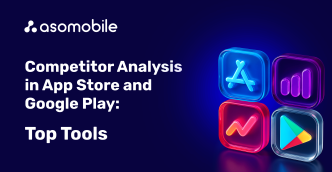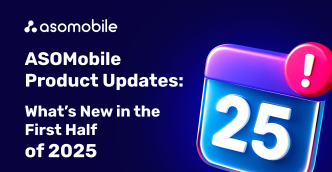How to Develop a Successful ASO Strategy for a Mobile Application
Every year, numerous articles are published in search of an answer to the question: How can an ASO strategy for the success of mobile applications be developed? In an ideal world, app development begins with an ASO strategy - defining the target audience, choosing an effective name, compiling a list of relevant keywords for metadata, and optimizing other essential elements. However, if you didn’t implement ASO during the development stage, there’s no need to worry - it can and should be integrated after the app’s release.
An app’s success is directly tied to its visibility. The higher its position in search results, the greater its chances of success. Without proper visibility, even the most outstanding app will go unnoticed and fail to reach its full potential. This article will explore how ASO can become your key to success.
ASO: Building a Successful Strategy
Why Every Mobile Product Needs an ASO Strategy
A well-structured ASO strategy highlights and distinguishes our app from countless similar ones. Launching a great app without ASO is like Dior designing a breathtaking dress and never showcasing it at Fashion Week.
App Store Optimization (ASO) is a continuous process of refining an app’s textual metadata and visual elements to enhance its visibility - both for the general user base and, more importantly, for the target audience. The formula is simple:
More visibility + More installs = Success. And where there’s success, monetization becomes more profitable.
Competitive Landscape in the App Store and Google Play
Statista shows over 1.9 million iOS apps and nearly 2.1 million Android apps are available. Every day, around 1,000 new apps are released across both stores. This means that competition is not just fierce - it’s relentless.
With the growing number of users and apps, Google and Apple are engaged in an ongoing battle to maintain relevance and engagement on their platforms. As a result, competition within both marketplaces is exceptionally high. To secure a place under the digital sun, developers must fight for visibility - and ASO is our most potent weapon in this battle.
How Do Users Discover Our App?
The journey from discovery to installation happens through several key channels:
1. Search (Search ASO)
Users find apps through keyword searches in the App Store and Google Play. In fact:
- Over 70% of users search for apps using the internal store search engines
- 65% of all installs come directly from search results
2. Organic (Organic ASO, Viral, Direct)
This includes viral mechanics, branding, social media, and external sources - essentially, any installations without direct advertising costs. Some of the most impactful organic acquisition channels include:
- Featuring (App Store & Google Play promotions)
- Branded traffic (users searching for the app by name)
- Referral mechanisms (word-of-mouth, influencer recommendations)
3. Paid Advertising (Paid User Acquisition - UA)
Paid methods for attracting users, including:
- Social media ad campaigns
- Marketplace promotions
- External advertising platforms
4. Additional Growth Strategies (Growth ASO)
Beyond search, organic, and paid channels, apps can also gain traction through:
- Featuring in curated app lists
- Optimizing and improving ratings & reviews
- Publishing in alternative app stores
These discovery channels are the main entry points for users to find and install our app. Whether they come through search, ads, or word-of-mouth, one thing is clear: no one will come at all without ASO.
What is ASO, and Why is it Essential?
ASO (App Store Optimization) is all about optimization - just like the name suggests, it’s about refining every aspect of an app to maximize its success. The term "optimization" speaks volumes like a Raffaello - one word replaces a thousand explanations.
ASO is a comprehensive enhancement of an app through both textual (title, keywords, metadata) and visual (icons, screenshots, videos) optimization strategies.
Although ASO principles apply to both the App Store and Google Play, the indexing mechanisms in each store differ, requiring a tailored approach for each platform. However, the core objectives remain the same:
- Increase visibility
- Boost installs
- Enhance user engagement
The higher these three numbers, the more successful the app becomes.
Key ASO Strategies
App Store Optimization is not just a set of techniques to improve an app’s store visibility. ASO is a comprehensive marketing strategy that includes market analysis, keyword optimization, app page refinement, localization, and review management. The best way to measure ASO's success is through profitability. Let’s explore the critical aspects of generating revenue through ASO.

1. Market Research and Competitor Analysis
Before developing an ASO strategy, it’s crucial to understand market size, target audience, and trends.
Market Analysis
- How big is the potential user base?
- Which countries offer the most growth opportunities?
- Who is our target audience (age, interests, behavior in stores)?
Trends
To stay ahead, you must track trends instead of following them.
- Which app niches are growing?
- What features or mechanics are currently popular?
- How are user preferences changing?
Competitor Analysis
How do we choose competitors? We analyze two groups:
- Direct competitors – similar apps with the same functionality
- Indirect competitors – apps that solve the same problem differently
How do we analyze competitors?
- Downloads, keyword usage, traffic channels (organic search, paid ads, PR activities)
- Competitor profiles – app page design, keyword strategy, ratings, reviews, advertising channels
- Adapting winning strategies – improving competitor keyword selection, enhancing their strong points while eliminating weak ones, and understanding why users choose them to offer a better alternative
2. Keyword Optimization and App Page Refinement
Proper keyword selection and placement are the foundation of ASO.
Finding Relevant Keywords (Building the Semantic Core)
- Focus on user search queries
- Use ASO tools for keyword research
- Analyze which keywords drive traffic to competitors
Where to Use Keywords?
- Title – the most critical space, containing core keywords
- Subtitle (iOS) / Short Description (Google Play) – complements the title
- Full Description – naturally integrates keywords
- Visuals - Screenshots and banners should reflect key user needs (text on images isn’t indexed but improves conversion). If using a video, include keywords in its title and description.
Testing and Analyzing Keyword Effectiveness
- Regularly track rankings
- A/B test different titles and descriptions
- Analyze conversion rate changes
3. Understanding Search Intent (Target Audience)
There are three types of user search intent, and ASO must adapt accordingly:
- Informational – users look for knowledge (e.g., "how to learn English"). Solution: use educational screenshots and text blocks
- Navigational – users search for a specific app (e.g., "Duolingo"). Solution: optimize branded queries
- Transactional – users are ready to act (e.g., "download home workouts"). Solution: strong call-to-action (CTA)
4. Localization and Seasonality
Localized apps receive 2-5 times more installs than English-only versions. Localization is not just about translation; it’s about adapting content to each market's cultural and linguistic preferences.
Successful Localization Strategies
Duolingo
- Fully translated UI, descriptions, reviews, and keywords
- Adjusted naming conventions: "Duolingo: Aprende Inglés" (Spanish) vs. "Duolingo: Englisch lernen" (German)
- Visual adjustments: country flags in Europe, cartoon elements in Japan
- Results: Downloads in Brazil increased by 200% and in Japan by 120%
TikTok
- Different names for different regions (Douyin in China, TikTok globally)
- Localized influencer previews
- Local keyword adjustments (e.g., "video status" for India, a popular search term)
- Results: Indian user base tripled in six months
Netflix
- Adapted content for different countries
- Localized descriptions and keywords based on search trends
- Country-specific top shows in screenshots (Stranger Things for the US, Sacred Games for India)
- Seasonal promotions (holiday discounts)
- Results: 50% higher install-to-subscription conversion rate in localized markets
Clash of Clans
- UI and color adjustments for Asian markets
- Different ad styles for Japan (minimalist approach)
- Integrated local payment methods
- Results: 80% revenue growth in Asia within a year
Seasonal Events in ASO
- New Year promotions
- Holiday-themed icons
- Fall campaigns (Back to School, Black Friday)
- Summer fitness and travel themes
- Example: fitness apps boosting summer installs by emphasizing weight loss
5. Using Paid Advertising
Paid advertising (ASA, Google Ads, Facebook Ads) can strengthen ASO. It drives traffic, improves app rankings, and allows A/B testing for creative assets. Retargeting campaigns also help retain users. However, paid traffic is wasted without ASO, as low conversion rates make ad spending ineffective.
6. Reviews and Ratings
Why is this important?
- 80% of users do not download apps rated below 4.0
- Raising a rating from 3.5 to 4.2 increases conversion rates by 35%
- Responding to negative reviews leads to improved ratings in 50% of cases
Methods to Improve Ratings
- Encourage satisfied users to leave reviews
- React quickly to negative feedback
- Analyze complaints and fix issues
Competitor Review Analysis
- What problems do their users face?
- How can we do better?
- What features do users expect?
7. Using ASO Tools like ASOMobile
The mobile market is saturated, and ASOMobile offers a complete toolset for app promotion. These tools allow developers to conduct in-depth market analysis.
- Competitor download and revenue tracking
- Marketplace category analysis and top chart insights
- App store comparisons
- Similar app analysis for strengths and weaknesses
Free ASO Tools to Try Now
- Keyword position tracking
- Keyword traffic volume estimation
- Google Play and App Store autocomplete suggestions
- Popular search queries
- Competitor keyword research
- Top charts tracking
- Featuring (store promotions) monitoring
- Category rankings
- Review responses and featured review tracking
8. ASO Strategy Success Checklist
- Audit all metadata (compare with top competitors)
- Launch A/B testing (visuals, keywords)
- Monitor ratings and reviews
- Track conversion rate changes after updates
- Analyze key metrics (DAU, MAU, CAC, ARPU, LTV)
- Regularly update the strategy based on trends
How to Measure an App’s Success with ASO Strategy
Applying these ASO strategies - either individually or in combination - will lead an app to success. Here’s what that looks like in numbers:
1. Impact of ASO on Organic Traffic
Apps that rank in the top 10 for relevant keywords receive 5-10 times more installs than those ranking lower. Apps in the top 3 for a keyword receive 70% of clicks. If an app isn’t in the top three, the likelihood of installation drops significantly - 90% of installs in Google Play come from the top three results.
Keyword optimization in iOS can increase organic installs by 30-50% within 2-4 months. As mentioned earlier, 65% of App Store and Google Play installs come from search, meaning most users discover apps through keywords rather than ads.
2. Conversion to Install (CVI) and the Role of Creatives
ASO can boost organic installs by 20-200%. Proper keyword and visual optimization typically increase conversion to install (CVI) by 15-35%.
- A/B testing an app’s icon can boost CVI by 15-40%.
- Changing an icon or the first screenshot in Google Play often increases installs by 20-30%.
- Adding a short, engaging video in Google Play can improve CVI by 20-35%, provided it’s concise and clear.
- The first screenshot is the most influential conversion factor; improving it can raise CVI by 10-30%.
3. Localization
Users prefer apps in their native languages, and translating metadata is crucial for broader reach. Localization can increase installs by 2-5 times, and translating an app into 10+ languages can result in a 200-300% install growth.
For example, localization in China, Japan, and South Korea increases CVI by 40-50% when the app is adapted for native users.
4. Ratings and Reviews
Managing ratings and reviews is a crucial part of ASO.
- Apps with a rating below 4.0 lose up to 50% of potential installs and are ignored by 80% of users.
- Increasing a rating from 3.5 to 4.2 can improve conversion rates by 35%.
- Even a 0.5-star increase in rating can boost installs by 30%.
- Responding to user reviews leads to improved ratings in 50% of cases.
5. Featuring
App Store features can increase organic installs by 200-800% in just one week. Even after the featuring period ends, 60-70% of apps continue experiencing long-term install growth.
ASO as a Holistic Growth Strategy
Optimizing the two core ASO elements - text and visuals - enhances other critical factors such as ratings, reviews, featuring, conversion, and localization. That’s why ASO isn’t just about optimization - it’s a comprehensive strategy impacting all aspects of user acquisition.
ASO is a powerful tool that directly influences visibility, conversion, and installs. Without it, even large marketing budgets can be spent inefficiently.
How ASO Strategies Drive App Growth
Effective ASO optimization has a direct impact on the growth of a mobile application.
It significantly increases organic traffic by ensuring the proper selection of keywords, optimized titles, and descriptions, improving the app’s visibility in search results.
Optimizing visual elements enhances conversion rates to installs. Well-designed and A/B-tested visuals (icons, screenshots, videos) make the app more appealing.
Analyzing reviews and behavioral factors helps reduce user churn. ASO aligns user expectations with the app’s content, improving retention rates.
Optimizing ad spend strengthens the app’s search rankings, leading to more free installs and reducing reliance on paid traffic.
Localization and adaptation to different languages and cultural preferences are crucial. The broader the localization, the larger the potential audience.
Implementing a comprehensive ASO strategy does not yield instant results, but a systematic approach ensures steady app growth, increased revenue, and long-term success.
 Українська
Українська  Русский
Русский  Español
Español 






